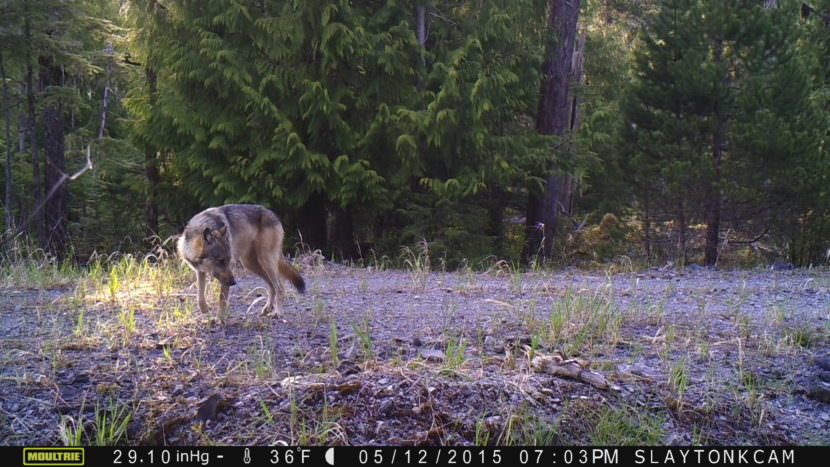
The wolf trapping season on Prince of Wales Island has been limited to one month in recent years. The Alaska Department of Fish and Game recently announced that the upcoming season would be the same. And it has left some residents who hunt the island’s deer population to ask, “What about us?”
A 2019 study said that wolves on Prince of Wales Island are more inbred than previously thought. Why is this a problem? Tom Schumacher, regional supervisor for the Alaska Department Fish & Game, invoked Isle Royale to explain it at a wolf harvest meeting in Craig on October 24.
“I think if you look around online, you can probably also find photographs of wolves with some pretty severe spinal deformities that were from Isle Royal. And there’s only one thing that explains that. And that’s inbreeding,” said Schumacher.
Isle Royale is an island in Lake Superior. It has a famously unstable population of wolves that at one point dwindled to two, partially because of severe inbreeding. It’s a cautionary tale around the Alexander Archipelago.
In 2019, Fish & Game switched from managing wolf hunting on a quota basis to a season-based system. They still use pre-season population estimates to determine the season’s length but at the time of the change, Fish and Game said tracking the number of wolves killed was proving too difficult to manage. The last three hunting seasons have been 31-day openings, starting November 15.
According to Schumacher, the month-long season is an attempt to preserve more wolves than the 150-200 mandated by the state – the thought being that hunters might be eliminating too many wolf genes from the island’s pool.
“Right now, if we ignore something like that, and something bad happens, that’s we’re not being responsible,” he said. “So, knowing this stuff and being responsible matters. We need to take some measures to learn more about it and manage accordingly until we know more.”
The estimated population ahead of this year’s season is 259, which Schumacher believes is right in the desired range. In 2019, Fish and Game opted for a two-month opening and a record 165 wolves were killed. Since then, the season and the number of wolves harvested have been cut in half and the desired population increased.
The condensed nature of wolf trapping on the island has added to an already controversial debate.
“So, are you gonna raise wolves, sacrifice the deer? Asked Mike Douville, a Craig resident and member of the Southeast Alaska Subsistence Regional Advisory Council (SEARAC). He says he is worried that preserving this many wolves means open season on the deer population, an important source of meat for island residents and wolves alike. “You know, because that’s the subsistence resource that’s probably the most important on this island. I realize it’s a difficult situation.”
Sam Sawyer, another island resident, expressed concern that management organizations like Fish & Game focus too many resources on the wolf population. “Who’s looking out for the deer population in all of this? It seems like the wolves are always the number one priority, but the deer never are.”
“At this point, we believe we have a more urgent issue with wolves,” said Schumacher but he recognizes the concern. “It’s not a perfect situation. I’ll give you that.”
Scientists are worried about inbreeding, which can lead to less fertility and survival. The term for this worrying lack of genetic diversity is homozygosity and its byproduct is inbreeding depression – meaning the closer the relation of the wolves that mate, the less fertile and more deformed the offspring can become. A woman in the meeting points out that these wolves have been on the island for hundreds of years. Why is homozygosity a problem now?
And the answer, Schumacher says, is that he doesn’t know if it is. Right now, he’ll call it an issue but not yet a problem.
“We don’t know that we have a problem here. These wolves have been here for a long time. But we’ve got some red flags, and we need to recognize those and manage accordingly,” he replied.
Schumacher noted that managers need better data and research. The state department currently tracks wolf abundance using hairboards, which are contraptions made of wood and barbed wire that are scented with trapping lure. The idea is the wolves will roll in it and leave behind hair to be sampled. But Schumacher admitted, “If there’s a group of wolves that won’t roll on them, you potentially have a problem with sampling. Like if you say all three-year-old females never roll on hairboards, then those animals are invisible to the sampling technique.”
He said the department is bringing in graduate students to try other methods of tracking the number of wolves on the island, like trail cameras and, interestingly, scat-detecting dogs.
“What does everybody do? Everybody poops. It’s something that we’re going to look at using scat-detecting dogs. And you can collect DNA from the animal that left the poop,” Schumacher announced. If the inbreeding turns out to be a big problem on Prince of Wales Island, then they may have to bring in wolves from the mainland to interbreed – but that is a last resort.
He added that if things go as anticipated, trappers on the island will be able to harvest 75-80 wolves this season.





